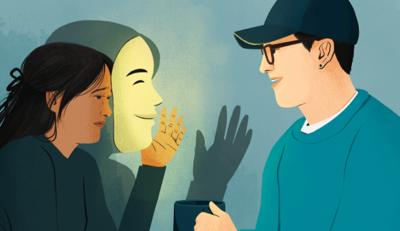
To understand masking, it helps to first understand stimming. Autistic folks - kids and adults alike - can often use repetitive behavior like spinning, flapping their hands, or walking on tippy-toes to calm their bodies. Yet, when neurotypical people see these “stims,” they may become upset or distracted. The autistic person is told to stop, or maybe they feel a social pressure to suppress their natural autistic traits.
This behavior is called masking, the effort to suppress traits to fit societal expectations. And it doesn’t just apply to stimming. While masking helps autistic people navigate social situations through forcing eye contact, body language, and social communication, it also takes a mental and emotional toll.
Raising awareness is key to creating spaces where autistic people feel accepted without the exhausting pressure to hide who they are. The following article explores how masking impacts autistic individuals and touches on why awareness and support are essential in recognizing and reducing the pressures that lead to masking.
What is Autistic Masking?
Autistic masking is the conscious or unconscious effort to hide or suppress traits to fit in. It’s consciously or unconsciously adjusting to appear neurotypical, often to avoid judgment, exclusion, or misunderstanding by their neurotypical peers.
While masking is sometimes used interchangeably with camouflaging, there is a distinction. Camouflaging is the broader act of blending in, while masking explicitly refers to the conscious effort to suppress autistic behaviors such as stimming, avoiding eye contact, or using scripted conversations. The strategy hides or masks social difficulties (Perry et al., 2022).
Common masking strategies include mimicking facial expressions, forcing eye contact or rehearsing social interactions in advance. While these help the autistic person pass as neurotypical and navigate daily life, they can come at the cost of their mental and emotional well-being.
Why Do Autistic People Mask?
Autistic people mask because of societal pressure to “fit in” to the neurotypical expectations in school, work, and social situations. From a young age, many people with Autism Spectrum Disorder (ASD) learn that certain behaviors, such as avoiding eye contact, stimming, or speaking directly, are “different” and may lead to exclusion or ridicule.
They may avoid being bullied, misunderstood, or mistreated by mimicking neurotypical behavior. For some, masking becomes so automatic they do it without conscious thought.
The Mental and Emotional Toll of Masking
While masking can help with social acceptance, constantly monitoring and adjusting to neurotypical expectations is mentally and physically exhausting. Many autistic people spend copious amounts of energy analyzing social cues, suppressing natural responses, and rehearsing interactions—all to avoid standing out.
This ongoing effort often leads to chronic stress, anxiety, and emotional burnout. Without being able to express themselves naturally, many autistic people feel deeply isolated, further reinforcing the cycle of masking and mental health struggles.
For undiagnosed autistic individuals, long-term masking can contribute to depression, fatigue, and a sense of disconnection from their true selves. It can also delay the recognition of autism, preventing access to support and accommodations.
Assessments Tools for Unmasking ASD
Assessment tools can help identify autistic traits obscured by years of masking. The Social Responsiveness Scale (SRS™-2) evaluates the presence and severity of social impairments within the autism spectrum disorder, differentiating them from those occurring in other disorders.
The Sensory Processing Measure (SPM™-2) provides a broad assessment of sensory integration and processing difficulties across different environments. The SPM-2 Quick Tips offer targeted intervention strategies to help manage sensory challenges, which are closely tied to masking-related stress.
Many autistic individuals also experience pragmatic language difficulties. For children and young adults, the Clinical Assessment of Pragmatics (CAPs™) comprehensively evaluates pragmatic language skills and social language development, helping professionals better understand and support communication challenges.
How to Support Autistic People That Mask
For clinicians working with individuals who may be autistic but have spent years masking, the Autism Diagnostic Observation Schedule (ADOS®-2) is a good starting point. It provides a structured approach to identifying autistic traits and guiding individuals toward appropriate support.
Because extensive masking can obscure traditional diagnostic indicators, the additional assessments below, used in combination with other diagnostic tools, can offer a more complete picture:
Social Responsiveness Scale (SRS™-2)
Sensory Processing Measure (SPM™-2)
SPM-2 quick tips (SPM-2)
Clinical Assessment of Pragmatics (CAPs™)
Early diagnosis and tailored support, whether through therapy coaching or workplace accommodations, can improve overall well-being and allow autistic individuals to thrive in environments that recognize and respect their needs.
WPS supports clinicians, educators, and researchers with evidence-based assessment tools that deliver results, ensuring autistic individuals receive the resources they need without the burden of masking.



(0) comments
We welcome your comments
Log In
Post a comment as Guest
Keep it Clean. Please avoid obscene, vulgar, lewd, racist or sexually-oriented language.
PLEASE TURN OFF YOUR CAPS LOCK.
Don't Threaten. Threats of harming another person will not be tolerated.
Be Truthful. Don't knowingly lie about anyone or anything.
Be Nice. No racism, sexism or any sort of -ism that is degrading to another person.
Be Proactive. Use the 'Report' link on each comment to let us know of abusive posts.
Share with Us. We'd love to hear eyewitness accounts, the history behind an article.